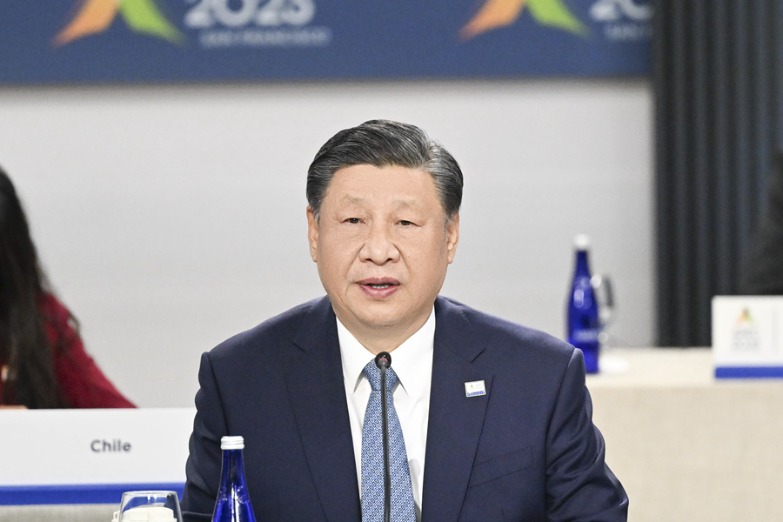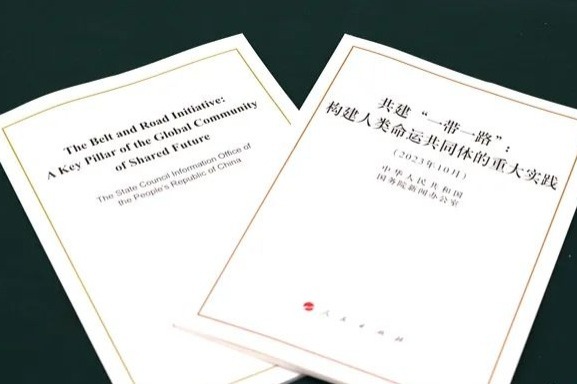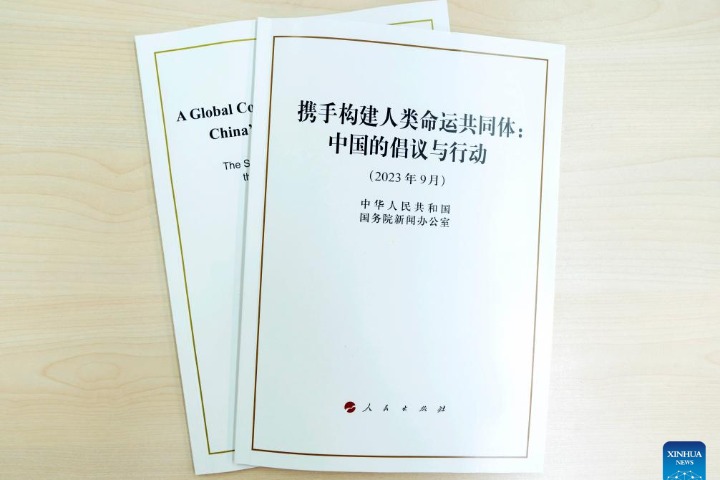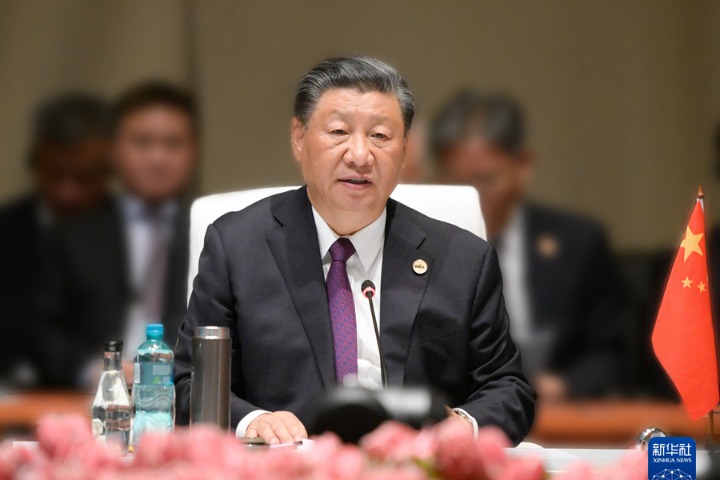《中国的核应急》白皮书双语全文
新华网 2016-01-27 10:24

五、核事故应对处置主要措施
V. Main Measures to Cope with Nuclear Accidents
中国参照国际先进标准,汲取国际成熟经验,结合国情和核能发展实际,制定了控制、缓解、应对核事故的工作措施。
By referring the advanced international standards and drawing on worldwide mature experience, China has defined working measures to control, mitigate and cope with nuclear accidents commensurate with its national conditions and actual situation of nuclear energy development.
实施纵深防御。设置五道防线,前移核应急关口,多重屏障强化核电安全,防止事故与减轻事故后果。一是保证设计、制造、建造、运行等质量,预防偏离正常运行。二是严格执行运行规程,遵守运行技术规范,使机组运行在限定的安全区间以内,及时检测和纠正偏差,对非正常运行加以控制,防止演变为事故。三是如果偏差未能及时纠正,发生设计基准事故时,自动启用电厂安全系统和保护系统,组织应急运行,防止事故恶化。四是如果事故未能得到有效控制,启动事故处理规程,实施事故管理策略,保证安全壳不被破坏,防止放射性物质外泄。五是在极端情况下,如果以上各道防线均告失效,立即进行场外应急响应行动,努力减轻事故对公众和环境的影响。同时,设置多道实体屏障,确保层层设防,防止和控制放射性物质释入环境。
Implementing the defense-in-depth concept. Five lines of defense have been set up under which the nuclear emergency preparedness threshold is moved ahead and multiple barriers are installed to strengthen nuclear safety, prevent accidents and mitigate the consequences of an accident. The five lines of defense are: First, the quality of design, manufacturing, construction and operation shall be assured to prevent deviation from normal operation; second, operation procedures and operation technical specifications shall be rigorously followed and observed to ensure that each nuclear generating unit is operated within the defined safety range, any deviations therefrom are detected and corrected in a timely manner, and any abnormal operation is controlled to prevent it from evolving into an accident; third, in case a deviation fails to be corrected in a timely manner, plant safety and protection systems shall be automatically activated upon occurrence of an accident within the design datum, and emergency operations shall be organized to prevent the situation deteriorating; fourth, in case an accident fails to be controlled effectively, accident handling procedures shall be activated with the accident management strategy enforced to ensure that the containment shall remain intact and no radioactive substances are released into the environment; and fifth, in the event of failure of the above-mentioned lines of defense, off-site emergency actions shall be immediately activated in an effort to minimize any impact from the accident on the public or the environment. Meanwhile, multiple physical barriers shall be set up to ensure that multiple lines of defense are in place to prevent and control release of radioactive substances into the environment.
实行分级响应。参照国际原子能机构核事故事件分级表,根据核事故性质、严重程度及辐射后果影响范围,确定核事故级别。核应急状态分为应急待命、厂房应急、场区应急、场外应急,分别对应Ⅳ级响应、Ⅲ级响应、Ⅱ级响应、Ⅰ级响应。前三级响应,主要针对场区范围内的应急需要组织实施。当出现或可能出现向环境释放大量放射性物质,事故后果超越场区边界并可能严重危及公众健康和环境安全时,进入场外应急,启动Ⅰ级响应。
Exercising a tiered response scheme. The level of a nuclear accident shall be determined in accordance with the nature and seriousness of the accident and scope of effect from radiation, based on the International Nuclear and Radiological Event Scale (INES) guidelines of the International Atomic Energy Agency. The nuclear emergency preparedness condition is divided into Emergency Standby, Building Emergency, On-Site Emergency and Off-Site Emergency, which respectively correspond to Level IV response, Level III response, Level II response and Level I response. The first three levels of response mainly focus on the organization and implementation of emergency actions within the site. Off-Site Emergency shall be announced with its corresponding Level I response activated upon occurrence of release or possible release of a large quantity of radioactive substances into the environment in which accident consequences have crossed boundaries of the site, with the possibility of seriously jeopardizing public health and environmental safety.
部署响应行动。核事故发生后,各级核应急组织根据事故性质和严重程度,实施以下全部或部分响应行动。
Deploying actions of response. Every level of nuclear emergency organization shall implement the following response actions in whole or in part depending upon the nature and seriousness of the accident:
——迅速缓解控制事故。立即组织专业力量、装备和物资等开展工程抢险,缓解并控制事故,努力使核设施恢复到安全状态,防止或减少放射性物质向环境释放。
― Mitigating and controlling the accident in a timely manner. A professional force, equipment and supplies shall be thrown into immediate engineering emergency measures to mitigate and control any accident in an attempt to bring the relevant nuclear installation back to a safe condition while preventing or minimizing the release of radioactive substances into the environment.
——开展辐射监测和后果评价。在事故现场和受影响地区开展放射性监测以及人员受照剂量监测等。实时开展气象、水文、地质、地震等观(监)测预报。开展事故工况诊断和释放源项分析,研判事故发展趋势,评价辐射后果,判定受影响区域范围。
― Conducting radiation monitoring and consequence assessment. Radiation monitoring shall be conducted at the site of the accident and areas affected and doses possibly absorbed by personnel shall be measured. Observation/surveillance and forecast on meteorological, hydrological, geological and seismic impacts shall be provided on a real-time basis. The accident conditions shall be diagnosed and substances released shall be analyzed to determine the accident evolution trend, evaluate radiation consequences and define the areas affected.
——组织人员实施应急防护行动。当事故已经或可能导致碘放射性同位素释放,由专业组织及时安排一定区域内公众服用稳定碘,以减少甲状腺的受照剂量。适时组织受辐射影响地区人员采取隐蔽、撤离、临时避迁或永久迁出等应急防护措施,避免或减少受到辐射损伤。及时开展心理援助,抚慰社会公众情绪,减轻社会恐慌。
― Organizing personnel to implement emergency protection actions. If radioactive isotope of iodine has already been released or may be released arising from an accident, a professional team shall organize the public within a given area to take stable iodine pills to minimize radiation exposure to the thyroid gland. The people in the affected area shall be duly organized to take emergency protection measures deemed necessary, including hiding, evacuating, seeking temporary shelter or permanently moving out in order to prevent or minimize injuries from radiation exposure. Psychological assistance shall be provided in a timely manner to minimize social anxiety and panic.
——实施去污洗消和医疗救治。由专业人员去除或降低人员、设备、场所、环境等放射性污染。组织核应急医学救援力量实施医学诊断、分类,开展医疗救治,包括现场紧急救治、地方医院救治和后方专业救治等。
― Arranging decontamination and medical treatment. Professionals shall be dispatched to remove or minimize radioactive pollution affecting people, equipment, premises and the environment. A nuclear emergency preparedness medical rescue force shall be organized to perform medical diagnoses, case identification and medical treatment, including on-site first-aid treatment, local hospital treatment and backup professional treatment.
——控制出入通道和口岸。根据受事故影响区域具体情况,划定警戒区,设定出入通道,严格控制各类人员、车辆、设备和物资出入。对出入境人员、交通工具、集装箱、货物、行李物品、邮包快件等实施放射性污染检测与控制。
― Controlling access passages and ports. Zones shall be demarcated according to the areas affected and strict control shall be enforced over the passage of people, vehicles, equipment and supplies in and out of the designated passages. People, vehicles, cargo containers, goods, travelers' belongings and parcels moving in or out of the border checkpoints shall be screened for radiation detection and control.
——加强市场监管与调控。针对受事故影响地区市场供应及公众心理状况,及时进行重要生活必需品的市场监管和调控。禁止或限制受污染食品和饮用水的生产、加工、流通和食用,避免或减少放射性物质摄入。
― Strengthening market supervision and regulation. Necessities shall be subject to market supervision and regulation in a timely manner in line with the supply of market and the public psych in the areas affected. Manufacturing, processing, circulation and consumption of contaminated food and drinking water shall be banned or limited, so as to prevent or minimize the intake of radioactive substances.
——维护社会治安。严厉打击借机传播谣言、制造恐慌等违法犯罪行为。在群众安置点、抢险救援物资存放点等重点地区,增设临时警务站,加强治安巡逻。强化核事故现场等重要场所警戒保卫,根据需要做好周边地区交通管制等工作。
― Maintaining social order. Illegal or criminal acts, such as spreading rumors to create panic, shall be dealt with rigorously. Additional makeshift police posts shall be established to reinforce security patrols in important locations such as settlement sites and storage places for rescue supplies. Security for important premises such as the site of the nuclear accident shall be enhanced, and traffic control in the surrounding areas shall be properly coordinated according to actual needs.
——发布权威准确信息。参照国际原子能机构做法,根据中国法律法规,由国家、省(区、市)和核设施营运单位适时向社会发布准确、权威信息,及时将核事故状态、影响和社会公众应注意的事项、需要个人进行防护的措施告知公众,确保信息公开、透明。
― Releasing accurate official information. Accurate and official information shall be duly published to the public by the central, provincial (regional or municipal) governments and operators of nuclear installations in accordance with International Atomic Energy Agency (IAEA) practice, and the laws and regulations of China to ensure that information with respect to nuclear accident status, effects on the public and individual protection measures shall be disclosed to the public in an open, transparent and timely manner.
——做好国际通报与申请援助。按照国际原子能机构《及早通报核事故公约》要求,做好向国际社会的通报。按照国际原子能机构《核事故或辐射紧急情况援助公约》要求,视情向国际原子能机构和国际社会申请核应急救援。
― Doing well in notifying the international community and requesting for help. Notification shall be given to the international community in accordance with the Convention on Early Notification of a Nuclear Accident of the IAEA. Request for assistance shall be made to the IAEA and the world community in accordance with the Convention on Assistance in the Case of a Nuclear Accident or Radiological Emergency of the IAEA, depending upon the actual situation.
建立健全国家核应急技术标准体系。建立包括设置核电厂应急计划区、核事故分级、应急状态分级、开展应急防护行动、实施应急干预原则与干预水平等完整系统的国家核应急技术标准体系,为组织实施核应急准备与响应提供基本技术指南。
Establishing a robust system of technical standards for national nuclear emergency preparedness. A complete system of technical standards for national nuclear emergency preparedness shall be established, and it covers the standards for classification of nuclear power plant emergency planning zones, nuclear accidents and emergency status, implementation of emergency protection actions, and definition of emergency intervention principles and levels of intervention, so as to provide a primary technical guideline for the implementation of nuclear emergency preparedness and response.
加强应急值班。建立核应急值班体系,各级核应急组织保持24小时值班备勤。在国家核事故应急办公室设立核应急国家联络点,负责核应急值班,及时掌握国内核设施情况,保持与国际原子能机构信息畅通。
Strengthening emergency on-duty system. An emergency on-duty system shall be established to ensure that each level of nuclear emergency organization stays on-duty 24 hours a day. National contact points for nuclear emergency preparedness under the national nuclear accident emergency office shall be on duty for nuclear emergency preparedness to collect information about domestic nuclear installations and keep the IAEA updated.
六、核应急演习演练培训与公众沟通
VI. Nuclear Emergency Preparedness Exercises, Drills, Training and Public Communication
中国高度重视核应急演习演练,切实加强专业培训,注重公众沟通,不断提高各级核应急组织应对处置严重核事故的能力水平,普及社会公众核安全应急知识,营造促进核能发展良好环境,树立全社会对发展核能事业信心。
China attaches great importance to nuclear emergency preparedness exercises, drills, training and public communication, and continuous efforts have been made to enhance the capabilities of nuclear emergency preparedness organizations at various levels to cope with nuclear accidents, popularize knowledge of nuclear safety and emergency preparedness, create an environment conducive to facilitating nuclear energy development and build society-wide confidence in the country's nuclear energy sector.
组织实施核应急演习。发布《核电厂核事故应急管理条例》《突发事件应急预案管理办法》《突发事件应急演练指南》《核应急演习管理规定》等规章,明确规定国家核应急演习方针原则、组织机构、内容形式、分类频次、保障准备、实施程序等。适应核能发展需要,定期举行全国性核应急联合演习;相关省(区、市)每2年至4年举行一次本级场内场外核应急联合演习;核设施营运单位每2年组织一次综合演习,每年组织多种专项演习,拥有3台以上运行机组的演习频度适当增加;核电站首次装投料前,所在地省级核应急管理机构组织场内场外联合演习。近年来,先后组织代号为“神盾—2009”“神盾—2015”的国家核应急联合演习,参演规模近6000人,日本、韩国、法国、巴基斯坦、国际原子能机构等派出官员、专家观摩。
Organizing nuclear emergency preparedness exercises. The policies and principles, organization, formats, classifications, frequency, safeguard preparation and implementation procedures for China's nuclear emergency preparedness have been clearly defined in such documents as Regulations on Emergency Measures for Nuclear Accidents at Nuclear Power Plants, Contingency Measures for Unexpected Events, Guideline on Emergency Exercises for Unexpected Events and Regulations on Nuclear Emergency Preparedness Exercises. To cater to the needs of nuclear energy development, national-level nuclear emergency preparedness joint exercises shall be conducted on a regular basis; provincial-level on-site and off-site joint exercises for nuclear emergency preparedness shall be conducted once every two to four years by the relevant provinces (autonomous regions or centrally administered municipalities); operators of nuclear installations shall conduct comprehensive exercises once every two years and special exercises for different purposes every year, with higher frequency for those which have three or more generating units. Prior to the initial fuel loading, an on-site and off-site joint exercise shall be organized by the provincial-level nuclear emergency management organization where the relevant nuclear power plant is located. National-level nuclear emergency joint exercises with the code names “Shendun-2009” and “Shendun-2015” have been conducted and observed by officials and experts from Japan, ROK, France, Pakistan and the IAEA, involving the participation of about 6,000 persons on the two occasions.
建立三级核应急培训制度。国家核应急管理机构负责全国核应急管理人员培训,省(区、市)核应急管理机构负责本行政区域内核应急人员培训,核设施营运单位负责本单位核应急工作人员专业技术培训。福岛核事故以来,中国各级举办培训班110多期,培训近万人次。目前,中国核应急管理人员、专业技术人员均参加过不同级别、专业的培训。
Establishing a three-level nuclear emergency preparedness training system. The state nuclear emergency preparedness management organization shall be in charge of training for nation-wide nuclear emergency preparedness management personnel; nuclear emergency preparedness management organizations at the provincial (regional and municipal) level shall be in charge of training for nuclear emergency preparedness personnel within their respective jurisdictions; operators of nuclear installations shall be in charge of providing professional skills training for their own staff in the field of nuclear emergency preparedness. Since the Fukushima accident, China has organized more than 110 training sessions for different levels of nuclear emergency preparedness organizations, attended by a total of 10,000 people. China's nuclear emergency preparedness management personnel and technical professionals have all attended nuclear emergency preparedness trainings of different levels and disciplines.
加强核应急公众沟通与信息发布。中国高度重视核应急公众沟通和信息发布,制定相关规定,明确公开透明、客观真实、权威可信、科学通俗的工作原则。各级核应急组织建立专门的核应急宣传队伍,适时向全社会宣传国家核能政策、核安全政策、核应急政策,增加核能发展透明度,确保公众享有核安全监督权、核应急准备与响应知情权。2013年以来,以“共筑核应急核安全防线、共促核能事业科学发展”为主题,多次组织全国范围核应急宣传活动,国内外受众面达到10亿人次。2015年1月,利用中国核工业创建60周年契机,开展一系列面向国内外的宣传活动。2015年12月,组织媒体走进中国核电企业,开展“助推核能发展、助力‘一带一路'”采访活动,向国内外集中展示中国核电技术先进性、核电安全可靠性、核电管理规范性、核应急准备充分性,产生了积极社会反响。各涉核企业、大专院校和有关团体还以各种形式开展涉核科普宣传活动,努力营造安全高效发展核能的良好氛围。
Reinforcing public communication and information disclosure about nuclear emergency preparedness. China attaches great importance to public communication and information disclosure regarding nuclear emergency preparedness by developing relevant regulations on the principles of transparency, objectivity, trustworthiness and scientific accuracy. Each level of nuclear emergency preparedness organization has established a special nuclear emergency preparedness publicity team to publicize national policies on nuclear energy, nuclear safety and nuclear emergency preparedness to the public and to enhance transparency of nuclear energy development to ensure the public's right to supervise nuclear safety and access to information on nuclear emergency preparedness and response. Since 2013 a number of nationwide nuclear emergency preparedness publicity activities with the theme “Joining Efforts to Establish Defense on Nuclear Emergency and for Nuclear Safety, and to Foster the Scientific Development of Nuclear Energy Sector” have been held, arousing extensive attention both at home and abroad. In January 2015 publicity activities targeting domestic and foreign audiences were successively conducted by nuclear-related organizations to mark the 60th anniversary of the launch of China's nuclear industry. In December 2015 the domestic and foreign media were invited to visit Chinese nuclear power enterprises for the well-received campaign “Boosting Nuclear Energy Development for the One Belt and One Road Initiative,” showcasing to Chinese audience the advanced nature of China's nuclear power technology, the safety and reliability of nuclear power, standardization of nuclear power management and adequacy of nuclear emergency preparedness, producing positive social repercussions. Nuclear-related enterprises, universities and colleges, and relevant organizations have conducted a variety of publicity activities in relation to the popularization of nuclear-related scientific knowledge in a bid to foster an atmosphere conducive to the safe and efficient development of nuclear energy.
香港特别行政区、澳门特别行政区毗邻广东省,特区公众和舆论关注内地核能发展。1992年以来,粤港双方针对广东大亚湾和岭澳核电站核应急事宜达成多项共识。国家核应急管理机构多次与广东省、香港特别行政区政府组织宣介会,不断充实粤港核应急合作机制内容,完善粤港核应急交流平台,及时回应公众关切,消除疑虑。中央政府有关部门还有针对性地与港澳地区相关部门联合开展各领域专业培训,提高当地人员专业水平,为保持香港、澳门繁荣稳定作出积极贡献。
As the Hong Kong and Macao special administrative regions (SAR) are adjacent to Guangdong Province, the public in Hong Kong and Macao pay close attention to the nuclear energy development in China's mainland. Since 1992 Guangdong Province and the Hong Kong SAR have reached consensus on a number of issues in relation to nuclear emergency preparedness associated with the Daya Bay and Ling Ao nuclear power plants in Guangdong. The state nuclear emergency management organ has, on more than one occasion, organized promotional activities in conjunction with Guangdong Province and the Hong Kong SAR to further enrich the contents of their collaborative mechanism on nuclear emergency preparedness, refine the communication platform for nuclear emergency preparedness between Guangdong and Hong Kong, and respond to public concerns in a timely manner to allay any misgivings. The relevant departments of the central government have held special training sessions focusing on various disciplines in conjunction with the departments concerned of Hong Kong and Macao SAR governments with a view to raising the professional level of the local public, therefore contributing positively to maintaining the prosperity and stability of both Hong Kong and Macao.
核能安全利用是关系台湾海峡两岸人民生命财产安全的大事,两岸双方对此高度重视。2011年10月,海协会与台湾海基会签署《海峡两岸核电安全合作协议》。在该协议框架下,两岸建立核应急事务联系机制,在核电安全法规与标准、核电厂事故紧急通报、核电厂环境辐射监测、核电厂事故紧急应变及准备等领域不断拓展交流与合作,取得积极成效。
As the safe use of nuclear energy is a major issue bearing on the safety of both life and property of people across the Taiwan Straits, both sides of the Straits lay great store by it. In October 2011 the Association for Relations across the Taiwan Straits and Straits Exchange Foundation signed the Cross-straits Nuclear Power Safety Cooperation Agreement. Under the framework of this agreement, a communication mechanism has been put in place between the two sides across the Straits on nuclear emergency matters, and positive achievements have reaped in expanded exchange and cooperation in such areas as regulations and standards concerning nuclear power safety, emergency reporting on nuclear power plant accidents, environmental radiation monitoring for nuclear power plants, and emergency response and preparations for nuclear power plant accidents.

















 英语点津微信
英语点津微信 双语小程序
双语小程序